TOYOTA SEQUOIA 2015 2.G Owners Manual
Manufacturer: TOYOTA, Model Year: 2015, Model line: SEQUOIA, Model: TOYOTA SEQUOIA 2015 2.GPages: 664, PDF Size: 13.16 MB
Page 581 of 664
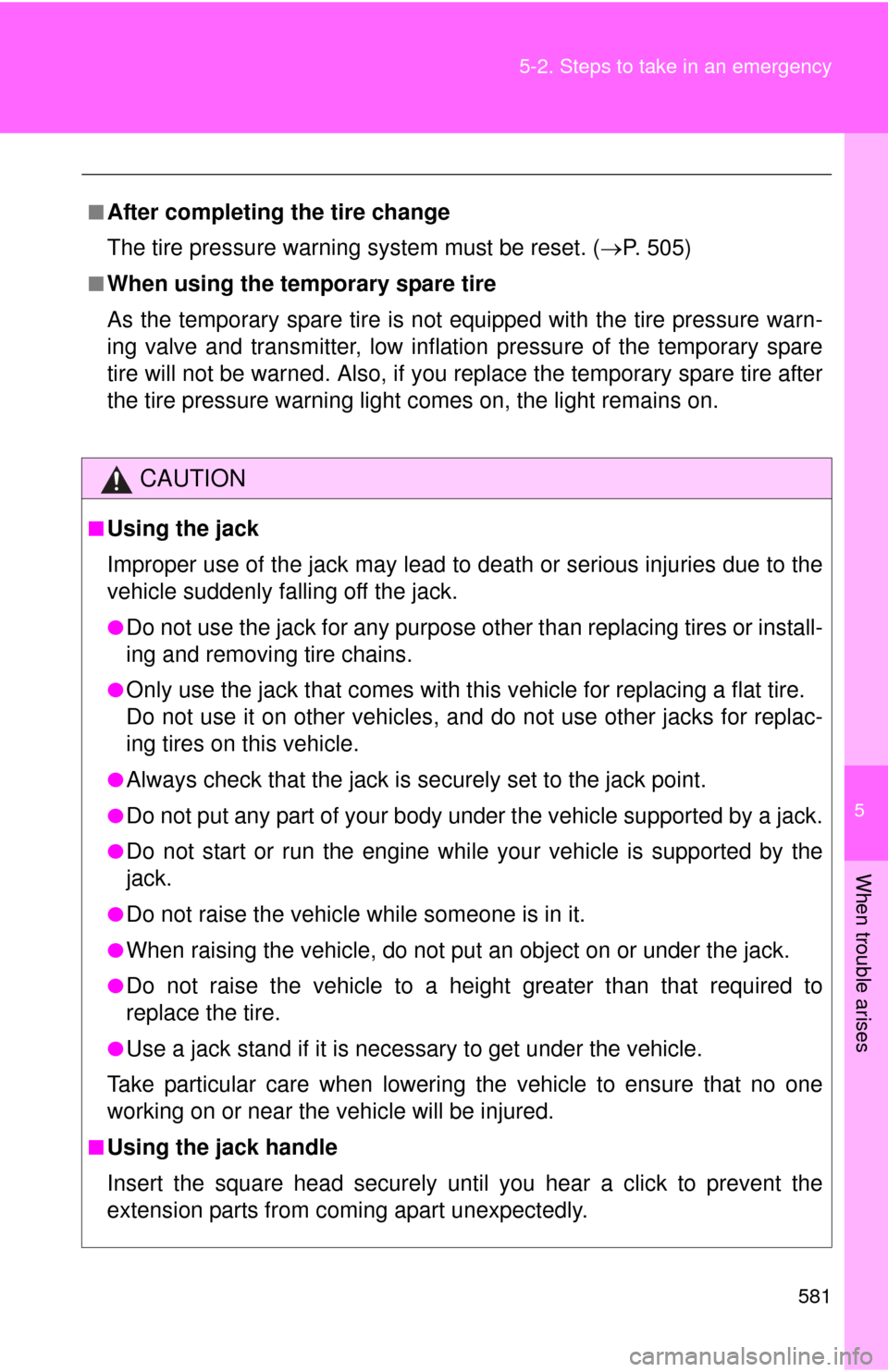
5
When trouble arises
581
5-2. Steps to take in an emergency
â– After completing the tire change
The tire pressure warning
system must be reset. (ď‚®P. 505)
â– When using the temporary spare tire
As the temporary spare tire is not equipped with the tire pressure warn-
ing valve and transmitter, low inflation pressure of the temporary spare
tire will not be warned. Also, if you re place the temporary spare tire after
the tire pressure warning light comes on, the light remains on.
CAUTION
â– Using the jack
Improper use of the jack may lead to death or serious injuries due to the
vehicle suddenly falling off the jack.
â—ŹDo not use the jack for any purpose other than replacing tires or install-
ing and removing tire chains.
â—ŹOnly use the jack that comes with this vehicle for replacing a flat tire.
Do not use it on other vehicles, an d do not use other jacks for replac-
ing tires on this vehicle.
â—ŹAlways check that the jack is securely set to the jack point.
â—ŹDo not put any part of your body under the vehicle supported by a jack.
â—ŹDo not start or run the engine while your vehicle is supported by the
jack.
â—ŹDo not raise the vehicle while someone is in it.
â—ŹWhen raising the vehicle, do not put an object on or under the jack.
â—ŹDo not raise the vehicle to a hei ght greater than that required to
replace the tire.
â—ŹUse a jack stand if it is necessary to get under the vehicle.
Take particular care when lowering the vehicle to ensure that no one
working on or near the vehicle will be injured.
â– Using the jack handle
Insert the square head securely until you hear a click to prevent the
extension parts from coming apart unexpectedly.
Page 582 of 664
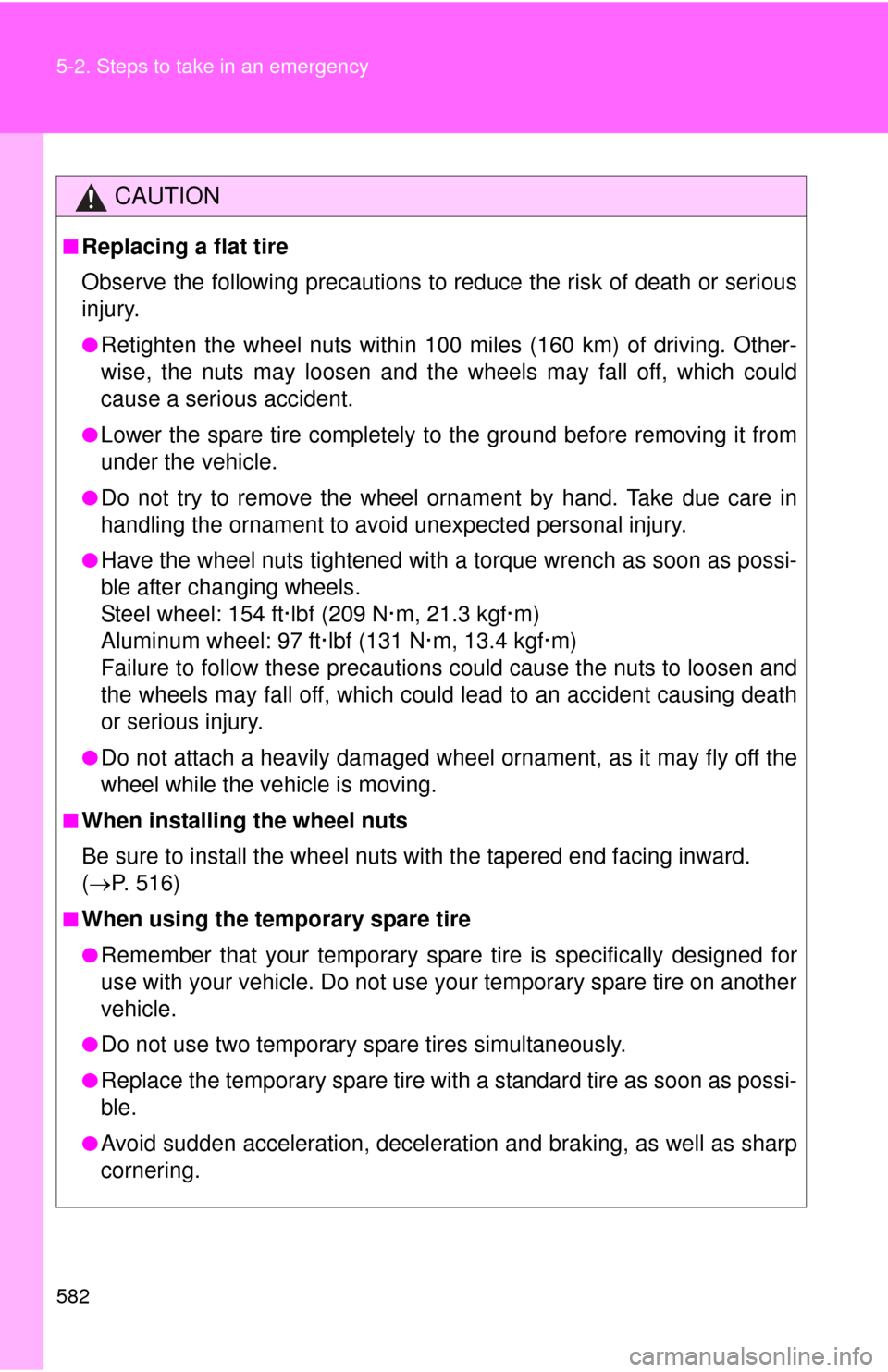
582 5-2. Steps to take in an emergency
CAUTION
â– Replacing a flat tire
Observe the following precautions to reduce the risk of death or serious
injury.
â—ŹRetighten the wheel nuts within 100 miles (160 km) of driving. Other-
wise, the nuts may loosen and the wheels may fall off, which could
cause a serious accident.
â—ŹLower the spare tire completely to the ground before removing it from
under the vehicle.
â—ŹDo not try to remove the wheel ornament by hand. Take due care in
handling the ornament to avoid unexpected personal injury.
â—ŹHave the wheel nuts tightened with a torque wrench as soon as possi-
ble after changing wheels.
Steel wheel: 154 ft·lbf (209 N·m, 21.3 kgf·m)
Aluminum wheel: 97 ft·lbf (131 N·m, 13.4 kgf·m)
Failure to follow these precautions could cause the nuts to loosen and
the wheels may fall off, which could lead to an accident causing death
or serious injury.
â—ŹDo not attach a heavily damaged wheel ornament, as it may fly off the
wheel while the ve hicle is moving.
â– When installing the wheel nuts
Be sure to install the wheel nuts with the tapered end facing inward.
(ď‚® P. 516)
â– When using the temporary spare tire
â—ŹRemember that your temporary spare tire is specifically designed for
use with your vehicle. Do not use your temporary spare tire on another
vehicle.
â—ŹDo not use two temporary spare tires simultaneously.
â—ŹReplace the temporary spare tire with a standard tire as soon as possi-
ble.
â—ŹAvoid sudden acceleration, deceleration and braking, as well as sharp
cornering.
Page 583 of 664
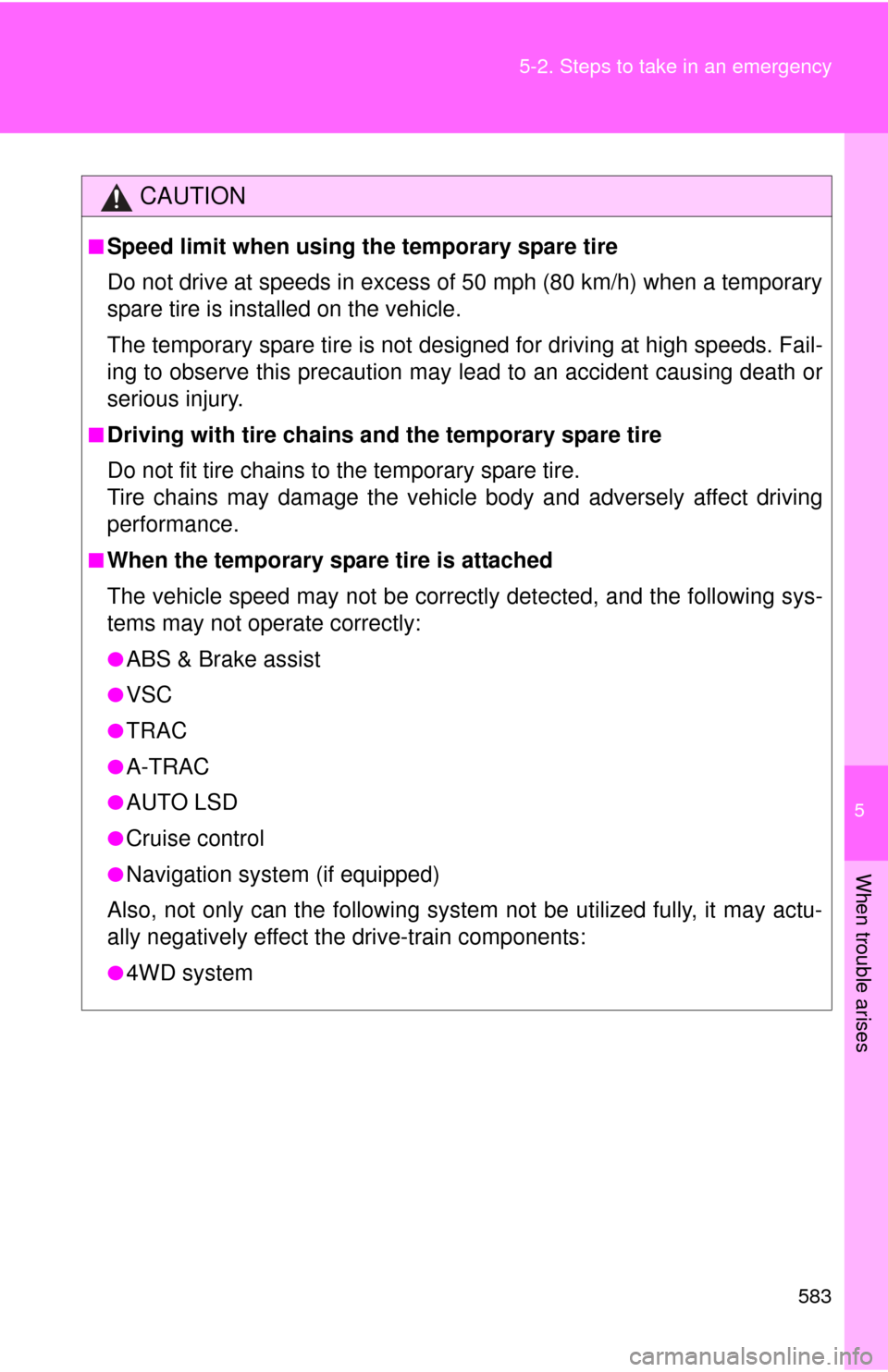
5
When trouble arises
583
5-2. Steps to take in an emergency
CAUTION
â– Speed limit when using the temporary spare tire
Do not drive at speeds in excess of 50 mph (80 km/h) when a temporary
spare tire is installed on the vehicle.
The temporary spare tire is not designed for driving at high speeds. Fail-
ing to observe this precaution may lead to an accident causing death or
serious injury.
â– Driving with tire chains and the temporary spare tire
Do not fit tire chains to the temporary spare tire.
Tire chains may damage the vehicle body and adversely affect driving
performance.
â– When the temporary spare tire is attached
The vehicle speed may not be correctly detected, and the following sys-
tems may not operate correctly:
â—ŹABS & Brake assist
â—ŹVSC
â—ŹTRAC
â—ŹA-TRAC
â—ŹAUTO LSD
â—ŹCruise control
â—ŹNavigation system (if equipped)
Also, not only can the following syste m not be utilized fully, it may actu-
ally negatively effect t he drive-train components:
â—Ź4WD system
Page 584 of 664

584 5-2. Steps to take in an emergency
NOTICE
â– Do not drive the vehicle with a flat tire.
Do not continue driving with a flat tire.
Driving even a short distance with a flat tire can damage the tire and the
wheel beyond repair.
â– When replacing the tires
â—ŹWhen removing or fitting the wheels, tires or the tire pressure warning
valve and transmitter, contact your Toyota dealer as the tire pressure
warning valve and transmitter may be damaged if not handled cor-
rectly.
â—ŹReplace the grommets for the tire pressure warning valves and trans-
mitters as well.
â– To avoid damage to the tire pressure warning valves and transmit-
ters
When a tire is repaired with liquid sealants, the tire pressure warning
valve and transmitter may not operate properly. If a liquid sealant is
used, contact your Toyota dealer or other qualified service shop as soon
as possible. Make sure to replace the tire pressure warning valve and
transmitter when replacing the tire. ( ď‚®P. 505)
Page 585 of 664
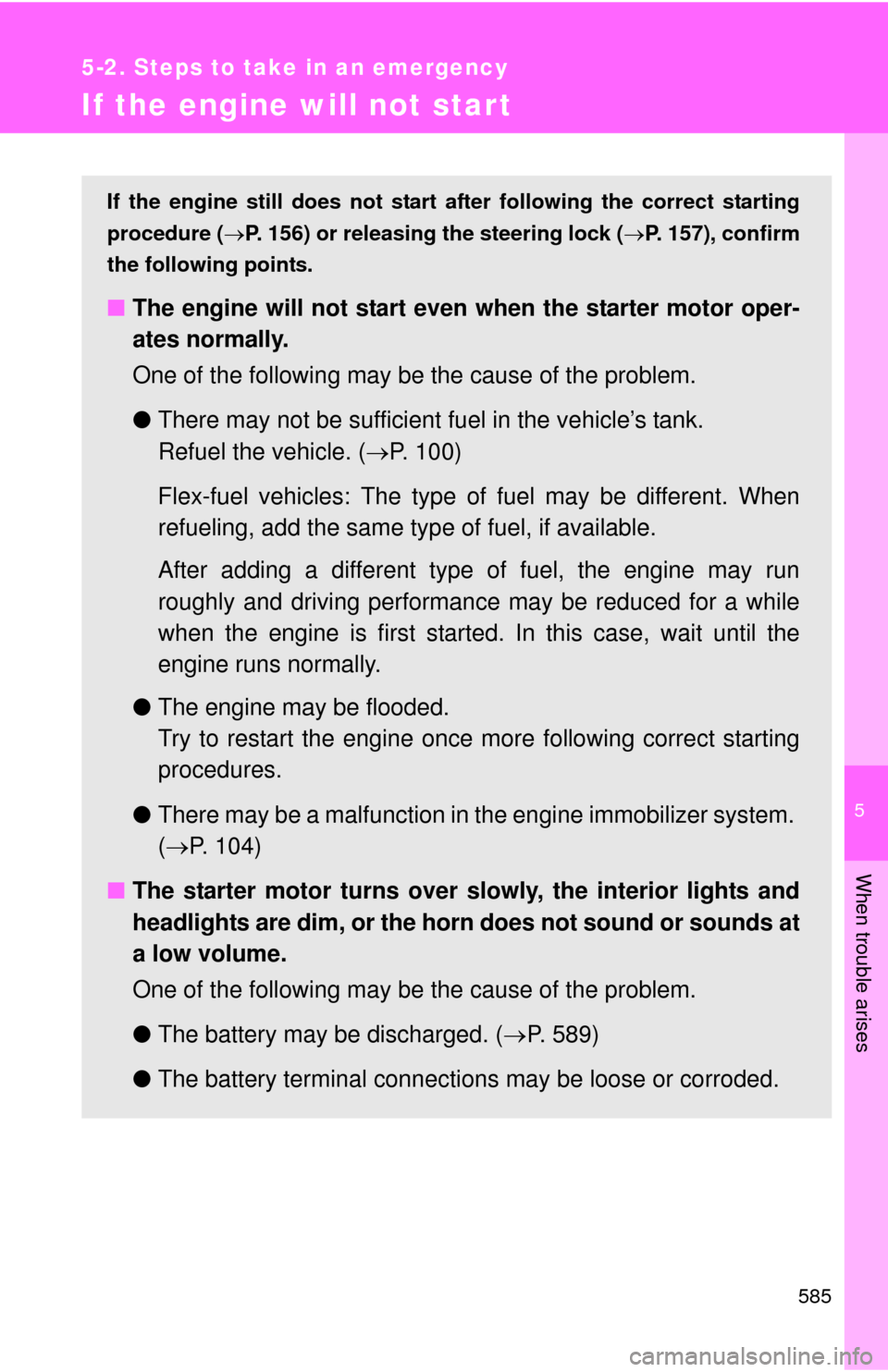
5
When trouble arises
585
5-2. Steps to take in an emergency
If the engine will not star t
If the engine still does not start after following the correct starting
procedure ( ď‚®P. 156) or releasing the steering lock (ď‚®P. 157), confirm
the following points.
â– The engine will not start even when the starter motor oper-
ates normally.
One of the following may be the cause of the problem.
●There may not be sufficient fuel in the vehicle’s tank.
Refuel the vehicle. ( ď‚®P. 100)
Flex-fuel vehicles: The type of fuel may be different. When
refueling, add the same type of fuel, if available.
After adding a different type of fuel, the engine may run
roughly and driving performance may be reduced for a while
when the engine is first started. In this case, wait until the
engine runs normally.
â—Ź The engine may be flooded.
Try to restart the engine once more following correct starting
procedures.
â—Ź There may be a malfunction in the engine immobilizer system.
( ď‚® P. 104)
â– The starter motor turns over slowly, the interior lights and
headlights are dim, or the horn does not sound or sounds at
a low volume.
One of the following may be the cause of the problem.
â—ŹThe battery may be discharged. ( ď‚®P. 589)
â—Ź The battery terminal connec tions may be loose or corroded.
Page 586 of 664
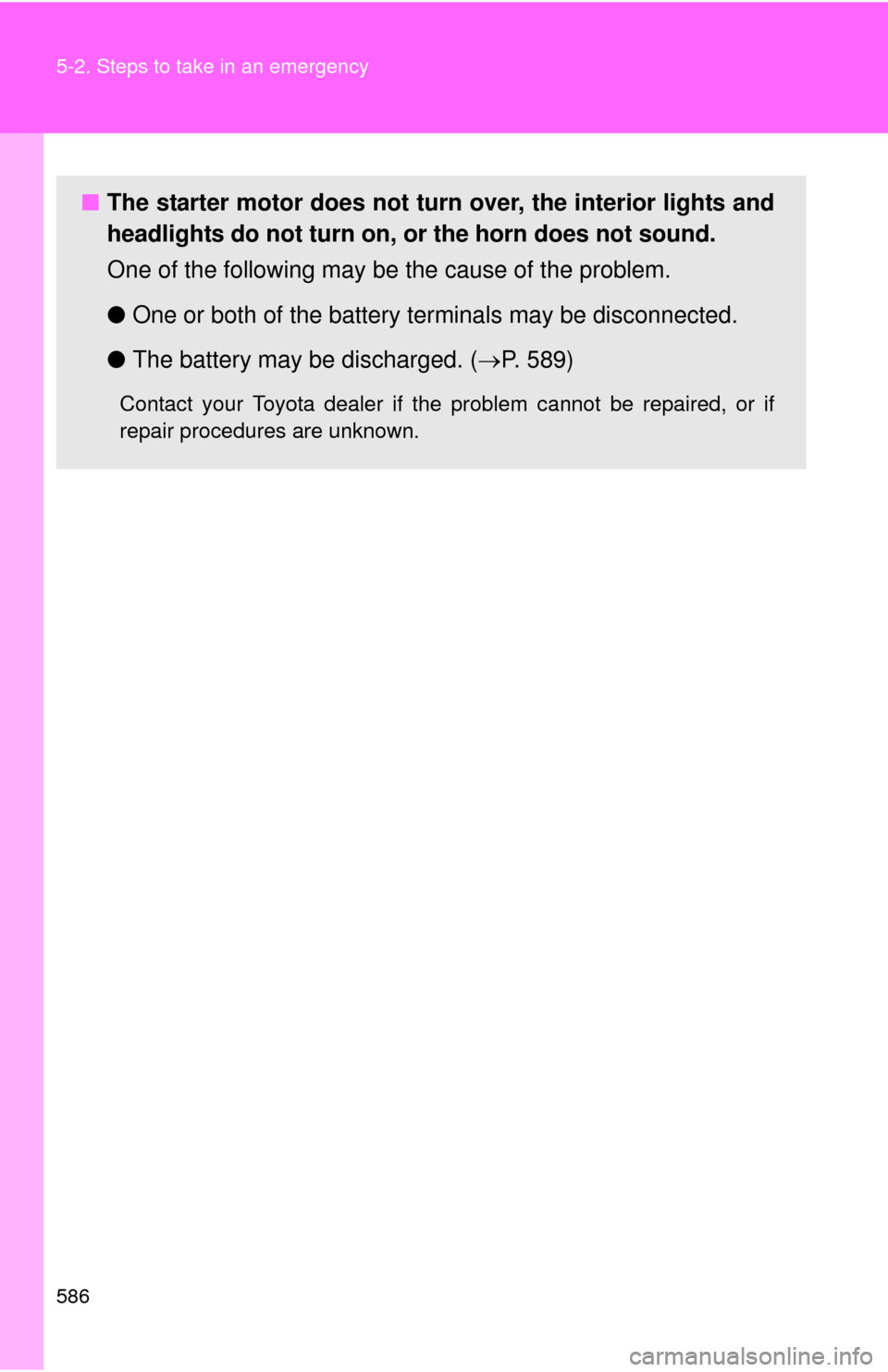
586 5-2. Steps to take in an emergency
â– The starter motor does not turn over, the interior lights and
headlights do not turn on, or the horn does not sound.
One of the following may be the cause of the problem.
â—Ź One or both of the battery terminals may be disconnected.
â—Ź The battery may be discharged. ( ď‚®P. 589)
Contact your Toyota dealer if the problem cannot be repaired, or if
repair procedures are unknown.
Page 587 of 664
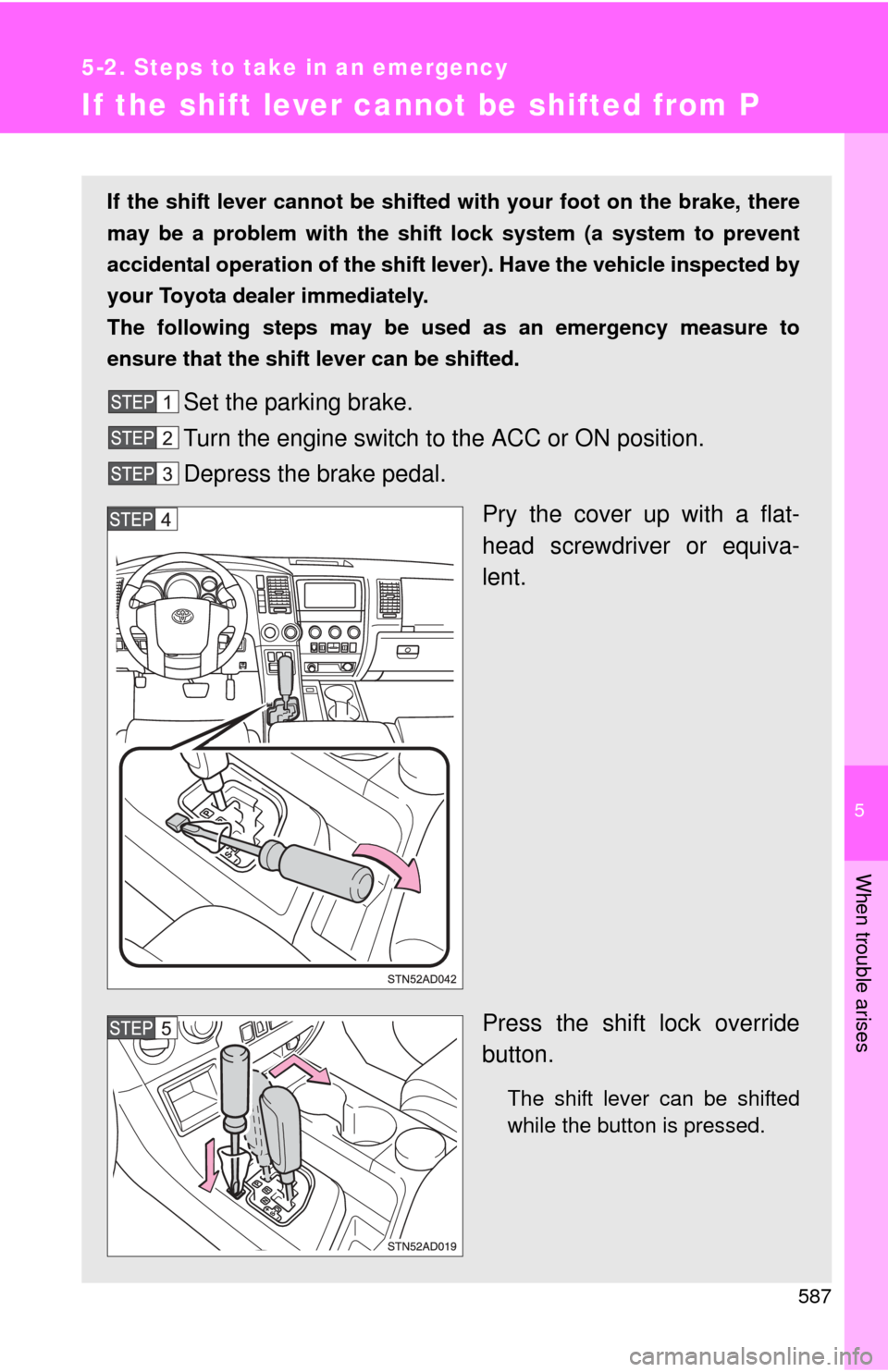
5
When trouble arises
587
5-2. Steps to take in an emergency
If the shift lever cannot be shifted from P
If the shift lever cannot be shifted with your foot on the brake, there
may be a problem with the shift lock system (a system to prevent
accidental operation of the shift lever). Have the vehicle inspected by
your Toyota dealer immediately.
The following steps may be used as an emergency measure to
ensure that the shift lever can be shifted.
Set the parking brake.
Turn the engine switch to the ACC or ON position.
Depress the brake pedal.
Pry the cover up with a flat-
head screwdriver or equiva-
lent.
Press the shift lock override
button.
The shift lever can be shifted
while the button is pressed.
Page 588 of 664
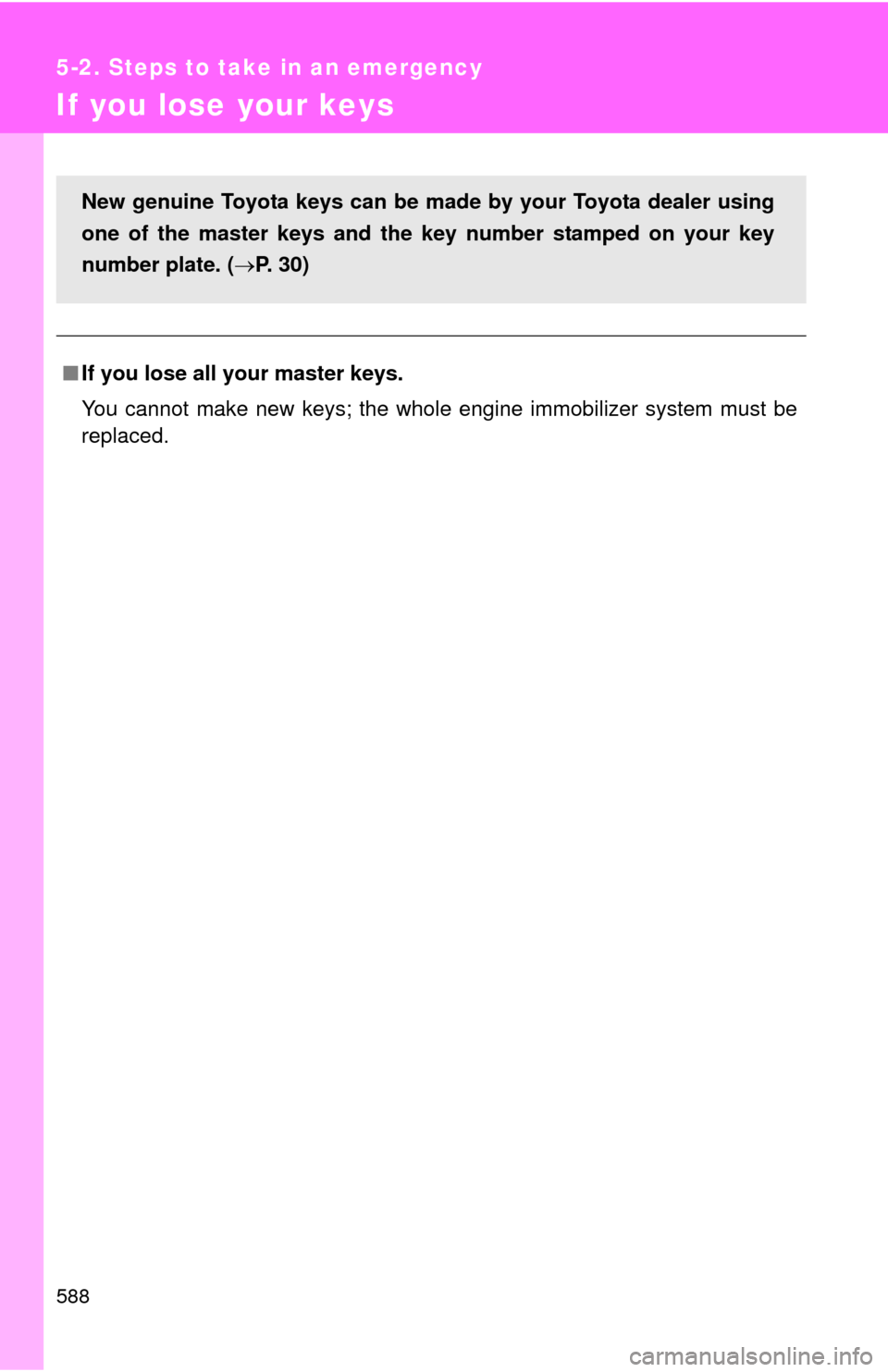
588
5-2. Steps to take in an emergency
If you lose your keys
â– If you lose all your master keys.
You cannot make new keys; the whole engine immobilizer system must be
replaced.
New genuine Toyota keys can be made by your Toyota dealer using
one of the master keys and the key number stamped on your key
number plate. ( ď‚®P. 30)
Page 589 of 664
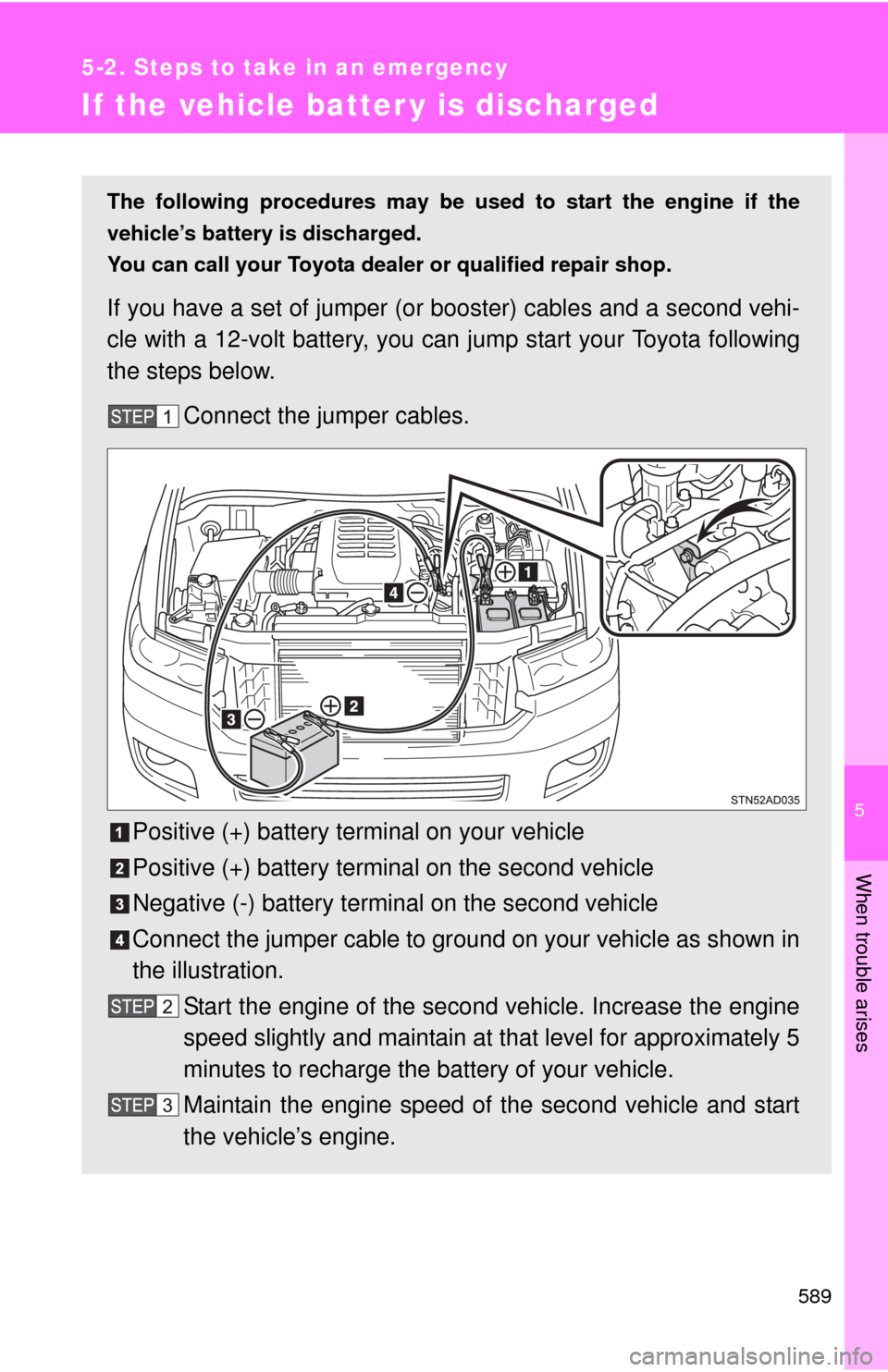
5
When trouble arises
589
5-2. Steps to take in an emergency
If the vehicle batter y is discharged
The following procedures may be used to start the engine if the
vehicle’s battery is discharged.
You can call your Toyota dealer or qualified repair shop.
If you have a set of jumper (or boo ster) cables and a second vehi-
cle with a 12-volt battery, you can jump start your Toyota following
the steps below.
Connect the jumper cables.
Positive (+) battery terminal on your vehicle
Positive (+) battery terminal on the second vehicle
Negative (-) battery terminal on the second vehicle
Connect the jumper cable to ground on your vehicle as shown in
the illustration. Start the engine of the second vehicle. Increase the engine
speed slightly and maintain at that level for approximately 5
minutes to recharge the battery of your vehicle.
Maintain the engine speed of the second vehicle and start
the vehicle’s engine.
Page 590 of 664
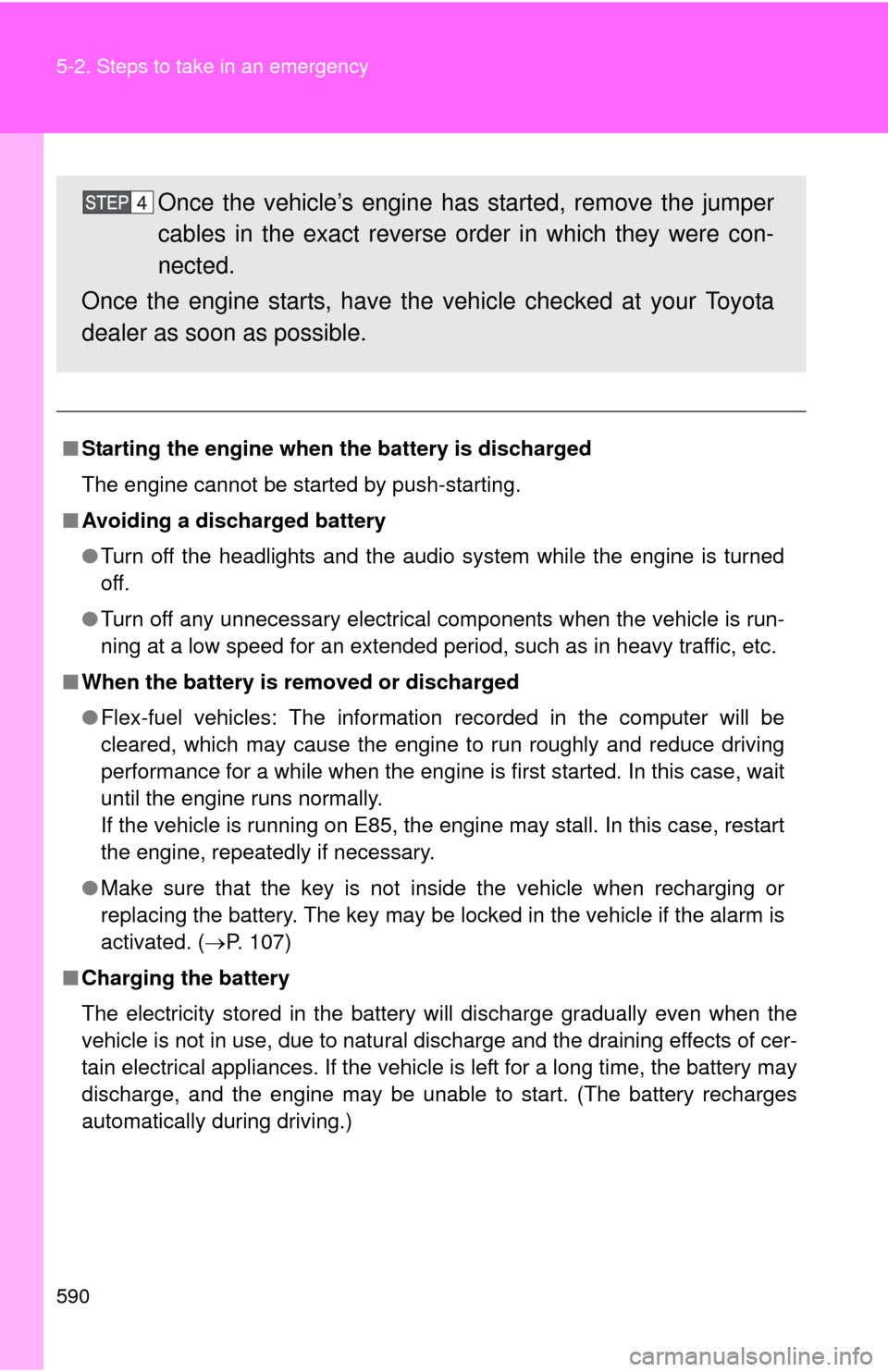
590 5-2. Steps to take in an emergency
â– Starting the engine when the battery is discharged
The engine cannot be started by push-starting.
â– Avoiding a discharged battery
â—ŹTurn off the headlights and the audio system while the engine is turned
off.
â—Ź Turn off any unnecessary electrical components when the vehicle is run-
ning at a low speed for an extended period, such as in heavy traffic, etc.
â– When the battery is removed or discharged
â—ŹFlex-fuel vehicles: The information recorded in the computer will be
cleared, which may cause the engine to run roughly and reduce driving
performance for a while when the engine is first started. In this case, wait
until the engine runs normally.
If the vehicle is running on E85, the engine may stall. In this case, restart
the engine, repeatedly if necessary.
â—Ź Make sure that the key is not inside the vehicle when recharging or
replacing the battery. The key may be locked in the vehicle if the alarm is
activated. ( ď‚®P. 107)
â– Charging the battery
The electricity stored in the battery will discharge gradually even when the
vehicle is not in use, due to natural discharge and the draining effects of cer-
tain electrical appliances. If the vehicle is left for a long time, the battery may
discharge, and the engine may be unable to start. (The battery recharges
automatically during driving.)
Once the vehicle’s engine has started, remove the jumper
cables in the exact reverse order in which they were con-
nected.
Once the engine starts, have the vehicle checked at your Toyota
dealer as soon as possible.